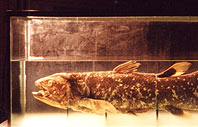|
It was thriving long before the dinosaurs ruled the Earth, and
scientists thought it had died out more than 65 million years ago.
But in 1938, fishermen on a South African trawler netted a massive,
scaly, blue-gray fish, and suddenly the long-extinct creature from
the depths was back, stunning scientists and capturing headlines
across the world. In "Ancient Creature of the Deep," NOVA tells the
story of the coelacanth, the most famous of all "living fossils."
The coelacanth story has more improbable twists than a crime
thriller. The chance discovery in 1938 was topped by a bizarre
stroke of fate in 1997, thousands of miles away from the original
find. A marine biologist was casually strolling through a fish
market in Indonesia when he spotted a new subspecies lying on a slab
in a fish market. That find triggered a renewed hunt for the elusive
creature in the wild. When a submersible finally revealed the fish's
underwater lair, scientists were greeted with video images of
coelacanths performing a bizarre "headstand" dance in the depths.
But having survived the theorized meteor strike that killed off the
dinosaurs, will this hardy creature now withstand the attention from
museums, aquariums, and media, all eager to acquire a specimen of
their own?
It all started on December 22, 1938, when Marjorie
Courtenay-Latimer, curator of a small natural history museum near
the tip of South Africa, spotted an unusual specimen on the deck of
a fishing trawler that had just returned with a pile of sea life
netted after a freak storm. "From underneath this crowd there was
this one fin sticking out—this blue fin," Latimer tells NOVA
more than 60 years after the event. "I thought, 'What on Earth could
this be?' ... There was this beautiful, beautiful fish. Iridescent
colors ... five feet long ... rough scales ... big blue eyes, and
these peculiar limb-like fins—something that I've never seen
in a fish in my life."
When she got it back to her museum, Courtenay-Latimer made a sketch
and sent it to a friend for identification. The friend was Professor
J.L.B. Smith, a chemist and avid amateur fish expert at Rhodes
University in nearby Grahamstown. Smith was amazed when he got the
drawing and arranged to visit Latimer as soon as possible—by
which time a taxidermist had stuffed the mystery fish and discarded
its viscera for lack of a way to preserve them. (For more on the
pair's correspondence, see
Moment of Discovery.)
"Lass," he told her on confirming his wild hunch that it was an
animal previously known only from fossils millions of years old,
"this fish will be on the lips of every scientist in the world. It's
a coelacanth!" In his official report, Smith named the new genus
Latimeria after its discoverer. Finding it, Smith wrote, "was
like walking down the street and running into a dinosaur."
Desperate to get his hands on another specimen so he could study its
insides, Smith posted a reward all along the east African coast.
Fourteen years passed before he received a telegram that a
coelacanth may have turned up in a fisherman's catch in the Comoros
archipelago, which at the time was a French colony. Smith's journey
to inspect and retrieve the fish is straight out of a Tom Clancy
novel—with a plane on loan from the South African prime
minister, an aircrew suspicious of their passenger's sanity, a
clandestine meeting, a delivery of cash, and then an escape with the
prize just ahead of French customs officials.


|

|
At first glance, the coelacanth may look like just
another fish. But it's altogether different (See
Anatomy of the Coelacanth).

|
|
|

